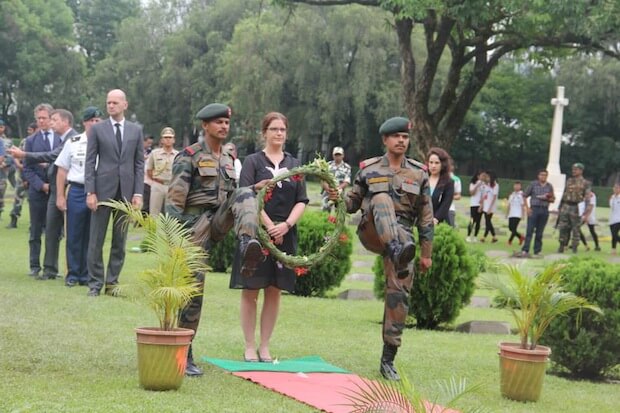This year marks an historic anniversary for the Allies in north-eastern India

For five members of the Royal Australian Air Force, the city of Imphal in Manipur, India, is their final resting place.
They have been buried at the War Cemetery there for seventy years now, having fallen at the Battle of Imphal in World War II.
They were honoured at a memorial service late last month, for their role in supporting the Allied campaign during what is now known to have been a fierce and significant battle.
The First Secretary for Defence at the Australian High Commission in New Delhi, Jane Spicer, represented Australia at commemorations to mark the 70th anniversary of the Battle of Imphal.
Dozens of Australians from the Royal Australian Air Force took part in the Battle of Imphal, which raged for five months in north-east India from March until July, 1944. The Japanese army attempted to destroy the Allied forces at Imphal, an Allied logistic base, and invade India, but were driven back into Burma.
After the Japanese conquered Burma in 1942, Imphal took on major military importance due to its geographical location west of the Burmese border. The Allied forces worked to improve the lines of communication and construct roads and airfields to transport supplies around the north of India.
Japanese intelligence, concluding that Imphal would be used as a base for a major offensive against them in Burma, decided to counter this by attacking first. Japanese Lieutenant-General Mutaguchi was ordered to prepare for ‘Operation U-Go’ – the capture of Imphal and Kohima – with 100,000 men.
Allied positions in the area became threatened and the decision was made to airlift in reinforcements and supplies.

The city of Imphal was held by the fourth corps of the British Fourteenth Army, along with four Indian Infantry Divisions, an Indian Parachute Brigade and an Indian Tank Brigade. The Indian divisions were composed of both British and Indian soldiers, including Gurkhas.
In late March, the Japanese cut off access to the road connecting Imphal and Kohima so the small number of Allied troops were forced to fight alone.
The siege of Imphal, as it is also known, continued for more than three months, and the only link the Allies had to the outside was by air.
A large part of the defence of Imphal was due to the work of the Air Force. During the siege, the Royal Air Force delivered more than 14,000,000 pounds of rations and 12,000 reinforcements.
Morale among the Allied defenders lifted substantially after the Japanese were defeated at Kohima in May 1944. In late June the troops from Kohima reached the men at Imphal, signalling the end of the siege.

Vicious battles took place surrounding the city of Imphal, including in the south along the road to Tiddim. The fighting here was so intense that it continued even after the siege had been lifted. Four Victoria Crosses (awarded for bravery) were won during this encounter.
Alongside the Battle of Kohima, the Battle of Imphal is widely regarded as the turning point of the Burma Campaign, and was one of the biggest defeats in Japanese history.
The Japanese army suffered huge losses with over 50,000 dead and missing, while the Allies sustained over 16,000 casualties.
Noted British historian Robert Lyman has said, “Kohima/Imphal was one of the four great turning-point battles in the Second World War, when the tide of war changed irreversibly and dramatically against those who initially held the upper hand”.






